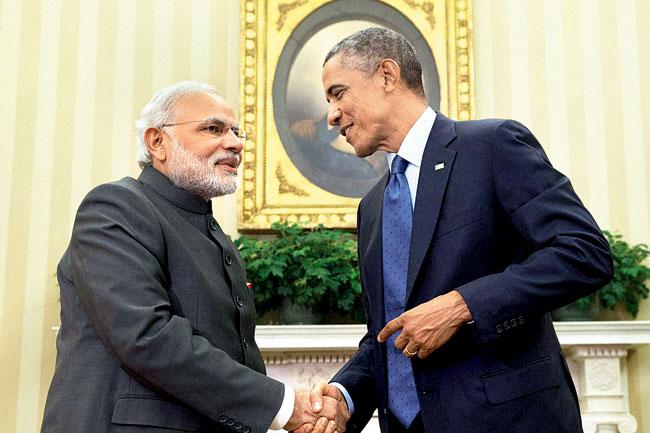The most crucial inclusion in the India-US joint statement issued on September 30 is the strategic partnership on energy and climate change

The most crucial inclusion in the India-US joint statement issued on September 30 is the strategic partnership on energy and climate change. The actions agreed will have far reaching impacts on India’s poor, neo-middle class and youth. They will also enhance the image of India as a steward in international negotiations on environment.

PM Modi and President Obama after briefing the media in the Oval Office on Tuesday. File Pic
ADVERTISEMENT
At World Trade Organisation (WTO), India resisted the American pressure to amend Trade Facilitation Agreement (TFA), only to protect the hundreds of millions of poor and hungry Indians. Now, India, through actions planned in partnership with the US, has a unique opportunity to act on climate change and secure the future of poor workers and farmers.
Till now India, over the last 17 years has been resisting, at international meetings, to avail an important the opportunity to make its refrigeration and air conditioning industry move away from a refrigerant — hydrochloroflurocarbons (HFCs). Nearly 100 countries, including the US and Japan and those in Europe, have given their consent but India continues to block this agreement, which is not for the interest of the poor.
The refrigeration and air-conditioning industry has made enormous contributions to protect the stratospheric ozone layer by effectively implementing the Montreal Protocol. By 2010, as per the Montreal Protocol, it had eliminated production and consumption of chlorofluorocarbons (CFCs). Now it, like other developing countries, is phasing out the last remaining ozone depleting chemical — hydrochlorofluorocarbons (HCFCs). However, in most cases, HFCs were introduced as an alternative to CFCs and now HCFCs.
The annual global growth of HFCs, used mainly in room and car air-conditioners, is eight per cent but in emerging economies like China and India, it is more than 10 to 15 per cent. It is likely to be 20 per cent soon due to increasing demand for air-conditioners from the rising neo-middle class.
As the plans declared by Prime Minister Narendra Modi for 100 smart cities go on stream, as the cold storage requirements increase to feed people in those cities, as the number of refrigerated facilities increase to prevent the wastage of perishables to give better income to farmers for their produce, the demand for HFCs would further rise.
Scientific studies say global action on HFCs will avoid up to 200 billion tonnes of CO2 emissions by 2050. But are alternatives to HFCs available? Godrej in India has already commercialised room air-conditioners without HFCs. It uses hydrocarbons (HC), which is cheaper and easily available in India. The energy efficiency of such air conditioners is at least 10 per cent higher.
India’s air-conditioning sector uses up to half of the available electricity during the sub-continent’s hottest months.
The demands burden India’s tattered power grid. The power outage in July 2012 was the largest in the history, which was blamed on the use of air conditioning systems.
Implementing HFC phase-down under the Montreal Protocol, India during negotiations can insist on applying the same rules as accepted under the Montreal Protocol — getting a grace period by requesting industrialised countries to carry out HFC phase-down first, ensuring that alternatives are available and affordable, getting full incremental cost of transition away from HFCs and getting the energy efficient and even super-efficient technology.
This opportunity is being withered away by India for the last few years by splitting hair on legal issues without understanding the larger interest of India’s poor and aspirations of the emerging neo-middle class.
Rajendra Shende is an IIT alumni, chairman of TERRE Policy Centre and former director of the UNEP. Views expressed are personal.
 Subscribe today by clicking the link and stay updated with the latest news!" Click here!
Subscribe today by clicking the link and stay updated with the latest news!" Click here!







